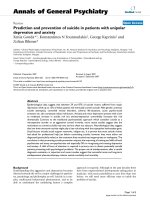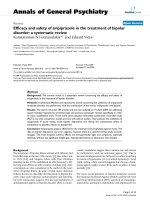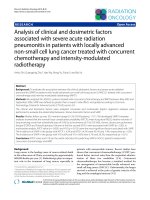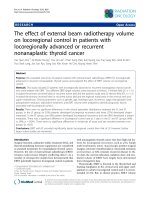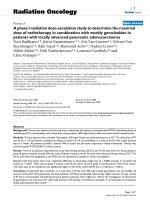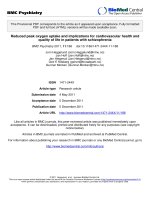Efficacy and safety of eribulin in patients with locally advanced or metastatic breast cancer not meeting trial eligibility criteria: A retrospective study
Bạn đang xem bản rút gọn của tài liệu. Xem và tải ngay bản đầy đủ của tài liệu tại đây (508.91 KB, 7 trang )
Iizumi et al. BMC Cancer (2017) 17:819
DOI 10.1186/s12885-017-3846-8
RESEARCH ARTICLE
Open Access
Efficacy and safety of eribulin in patients
with locally advanced or metastatic breast
cancer not meeting trial eligibility criteria: a
retrospective study
Sakura Iizumi1,2, Tatsunori Shimoi1,3* , Natsuko Tsushita1, Seiko Bun4, Akihiko Shimomura1, Emi Noguchi1,
Makoto Kodaira5, Mayu Yunokawa1, Kan Yonemori1, Chikako Shimizu1, Yasuhiro Fujiwara1 and Kenji Tamura1
Abstract
Background: The efficacy and safety of eribulin in patients with locally advanced or metastatic breast cancer has
been demonstrated in phase III trials. However, as patients receiving eribulin in daily practice do not necessarily meet
all the eligibility criteria of clinical trials, data for such patients are limited.
Methods: We identified patients with locally advanced or metastatic breast cancer, treated with eribulin monotherapy
between July 2011 and December 2015 at the National Cancer Center Hospital, Tokyo, Japan. Patients who would have
met the following eligibility criteria from the EMBRACE trial were included in the eligible group, and the rest were
included in the ineligible group: 1) Eastern Cooperative Oncology Group Performance status 0–2; 2) adequate
function of principal organs; and 3) absence of active infection. We compared the relative dose intensity (RDI),
tumor response, progression-free survival (PFS), overall survival (OS), and adverse events between the groups. Nominal
and continuous values were compared using the Fisher’s exact test and Mann-Whitney U test, respectively. Survival
outcomes were determined using Kaplan-Meier estimation, and between-group differences were assessed using the
log-rank test.
Results: Of the 203 patients included, 34 were classified into the ineligible group and 169 into the eligible group. Initial
dose reduction and treatment discontinuation due to adverse events (AEs) were more common in the ineligible group
(initial dose reduction: 23.5% in the ineligible group vs. 7.7% in the eligible group, p = 0.011; treatment discontinuation
due to AEs: 11.8% vs. 3.0%, p = 0.045). However, RDI (66% vs. 71%, p = 0.130), response rate (15.6% vs. 18.1%, p = 1.000),
PFS (3.7 months vs. 4.0 months, p = 0.913), OS (11.5 months vs. 16.1 months, p = 0.743), AEs requiring hospitalization (5.
9% vs. 6.5%, p = 1.000), and grade 3/4 AEs were similar in both groups. PFS, OS, AEs requiring hospitalization, and
discontinuation due to AEs in the eligible group were comparable to those found in previous phase III trials.
Conclusion: The safety and efficacy of eribulin monotherapy was demonstrated in a broader patient population than
that eligible for clinical trials. Eribulin may be a treatment option in these patients with locally advanced or metastatic
breast cancer, considering dose reduction and pre-existing dysfunctions.
Keywords: Breast cancer, Eribulin, Efficacy, Safety
* Correspondence:
1
Department of Breast and Medical Oncology, National Cancer Center
Hospital, 5-1-1 Tsukiji, Chuo-ku, Tokyo 104-0045, Japan
3
Course of Advanced Clinical Research of Cancer, Juntendo University
Graduate School of Medicine, 3-1-3 Hongoh, bunkyo-ku, Tokyo 113-0033,
Japan
Full list of author information is available at the end of the article
© The Author(s). 2017 Open Access This article is distributed under the terms of the Creative Commons Attribution 4.0
International License ( which permits unrestricted use, distribution, and
reproduction in any medium, provided you give appropriate credit to the original author(s) and the source, provide a link to
the Creative Commons license, and indicate if changes were made. The Creative Commons Public Domain Dedication waiver
( applies to the data made available in this article, unless otherwise stated.
Iizumi et al. BMC Cancer (2017) 17:819
Backgroud
Breast cancer is the most common cancer and leading
cause of cancer mortality in women worldwide [1]. Despite recent developments in treatment, metastatic breast
cancer remains incurable, and the 5-year survival rate is
only 26% [2]. The goals of treatment are to prolong survival and to improve or maintain quality of life. Chemotherapy plays an important role, especially in patients
with hormone-receptor negative or endocrine-resistant
breast cancer. However, few chemotherapeutic agents
have been shown to prolong overall survival (OS). While
anthracyclines and taxanes are commonly used as standard first-line therapy in the metastatic setting, there is
no single optimal subsequent-line chemotherapy [3].
Eribulin mesylate is a microtubule-inhibitor with a different mechanism from that of taxanes. It is the only
chemotherapeutic agent shown to increase OS after
treatment failure with anthracyclines and taxanes. Its
efficacy and safety have been demonstrated in clinical
trials, including two phase III trials, the EMBRACE and
Study 301 [4, 5]. In addition to trial populations, its
efficacy and safety in real-world populations have been
reported in retrospective studies [6–10]. Also, a
recently-published meta-analysis of retrospective series
provides important clinical implications, by comparing
the outcomes of eribulin in clinical practice and those
from trials [11]. However, the efficacy and safety, specifically in patients who would not have participated in
clinical trials, but who still receive eribulin in daily practice, have not been reported.
We conducted a retrospective study to assess the efficacy and safety of eribulin in patients with locally advanced or metastatic breast cancer who would not have
met the eligibility criteria of the EMBRACE trial.
Methods
Patients
We retrieved the medical records of patients with locally
advanced or metastatic, pathologically confirmed breast
cancer treated with eribulin monotherapy between July
2011 and December 2015 at the National Cancer Center
Hospital (Tokyo, Japan). Patients who received eribulin
at different hospitals before being treated at our hospital
or those with insufficient data regarding trial eligibility
were excluded from the analysis.
Definition of patient analysis groups (trial eligible and
trial ineligible)
We determined the eligibility of patients included in this
analysis according to the following criteria based on the
EMBRACE trial: 1) Eastern Cooperative Oncology Group
Performance status (PS) of 0 to 2; 2) adequate function of
principal organs (adequate bone marrow, renal, and liver
function as evidenced by absolute neutrophil count ≥1500/
Page 2 of 7
mm3, platelets ≥10 × 104/mm3, hemoglobin ≥10 g/dL,
serum creatinine ≤2.0 mg/dL, total bilirubin ≤1.5 times the
upper limit of normal [ULN], and aspartate transaminase
[AST] and alanine transaminase [ALT] ≤ three times ULN,
[AST and ALT ≤ five times ULN in patients with liver metastasis]); and 3) absence of active infection. Patients satisfying all these criteria were classified into the “eligible
group”; patients not satisfying any one of these criteria
were classified into the “ineligible group.” We selected the
criteria that may independently affect the efficacy (or dose
intensity [DI]) or safety of eribulin and that were welldocumented by the medical records. We considered that
factors regarding prior chemotherapy (including the no. of
prior chemotherapy lines) do not affect the efficacy or
safety of eribulin by themselves; thus, we did not include
them for the criteria for the classification. Life expectancy,
stable brain metastasis, and peripheral neuropathy were
not included because they were not necessarily welldocumented at the initiation of eribulin.
Treatment
Patients received intravenous infusions of eribulin mesylate 1.4 mg/m2 over 2–5 min on days 1 and 8 of each
21-day cycle. The dosing was adjusted according to dose
modification recommended by the FDA prescribing information [12], adverse events, or the physicians’ judgment. Treatment cycles were repeated until progressive
disease or unacceptable toxicity, or until the patient decided to terminate treatment.
Assessment
We assessed tumor response according to the Response
Evaluation Criteria in Solid Tumors (RECIST), version
1.1 [13] by using computed tomography (CT) scans. CT
scans were obtained every other cycle or sooner if
needed. Confirmation of response was not required. Response rate (RR) and disease control rate (DCR) were
defined as proportions of patients who achieved at least
partial response and stable disease as best response, respectively. Progression-free survival (PFS) was defined as
the time from the initiation of eribulin monotherapy
until either clinical or objective disease progression, or
death. OS was defined as the time from the initiation of
eribulin monotherapy until death. We also assessed relative dose intensity (RDI), DI and planned dose intensity
(PDI) according to the following formula:
RDI (%) = DI/PDI ×100,
DI (mg/week) = Cumulative dose/treatment duration,
PDI (mg/week) =1.4 × 2/3
Adverse events (AEs) were assessed using the Common Terminology Criteria for Adverse Events (CTCAE),
version 4.0.
Iizumi et al. BMC Cancer (2017) 17:819
Statistical analysis
The study was designed to compare the efficacy (RR,
DCR, PFS, and OS) and safety (frequency of grade 3 or
worse AEs, discontinuation due to AEs, and AEs requiring hospitalization) of eribulin between the eligible
group and the ineligible group. Nominal values and continuous values were compared using Fisher’s exact test
and Mann-Whitney U test, respectively. Only patients
with target lesions were analyzed for RR and DCR. Survival outcomes were obtained using Kaplan-Meier estimates, and the differences between the two groups were
assessed using log-rank test. Tests were considered significant if the two-sided p-value was <0.05. Analyses
were performed with EZR (Saitama Medical Center, Jichi
Medical University, Saitama, Japan), which is a graphical
user interface for R (The R foundation for Statistical
Computing, Vienna, Austria) [14].
Page 3 of 7
grade 2 for all unmet criteria, except for increased AST/
ALT levels (grade 3). All patients had PS of 0–2, except for
one patient (2.9%) with a PS of 3 because of pain from
bone metastases. One patient had an infection of a cutaneous metastasis, which required antibiotic administration.
Relative dose intensity, cumulative dose, and initial dose
reduction
The initial dose was reduced more frequently in the ineligible group than in the eligible group (8/34 [23.5%] vs.
13/169 [7.7%], p = 0.011). However, there was no significant difference in RDI (%) between the ineligible group
and the eligible group (median: 66, range: 38–97 vs. median 72, range 27–102; p = 0.130) or cumulative dose
(mg) (median: 14.3, range: 2.0–59.5 vs. median: 16.0,
range: 1.5–109.2; p = 0.389) (Additional file 1: Table S1).
Results
Efficacy
Patients
There was no significant difference in RR between the
ineligible group and the eligible group (15.6%; 95% confidence interval [CI], 5.3–32.8% vs. 18.1%; 95% CI, 12.1–
25.3%; p = 1.000) or DCR (65.6%; 95% CI, 46.8–81.4% vs.
62.5%; 95% CI, 54.1–70.4%; p = 0.841) (Additional file 2:
Table S2). The RR and DCR in the total population were
17.6% (95% CI, 12.3–24.1%) and 63.1% (95% CI, 55.5–
70.2%), respectively.
Figure 2 shows the Kaplan-Meier curves for PFS and
OS. There was no significant difference between the ineligible group and the eligible group in PFS (median:
3.7 months vs. 4.0 months, p = 0.913) or in OS (median:
11.5 months vs. 16.1 months, p = 0.743). The medians
for PFS and OS in the total population were 4.0 months
(95% CI, 3.5–4.8 months) and 15.9 months (95% CI,
13.8–18.5 months), respectively. The proportion of patients who received treatment after eribulin was 52.9%
in the ineligible group and 65.1% in the eligible group.
A total of 203 patients were included in the analysis: 34
were included in the ineligible group and 169 in the eligible group (Fig. 1). Baseline patient characteristics are
shown in Table 1. The proportion of patients with hormone receptor-positive breast cancer (estrogen receptor
+ and/or progesterone receptor+) was lower in the eligible group than in the ineligible group (58.8% vs. 79.3%,
p = 0.024); otherwise, there was no significant difference
in patient characteristics between groups.
Worst CTCAE grade leading to exclusion from the eligible
group
Table 2 shows the numbers of patients who did not meet
each of the eligibility criteria, with the worst grade of the
pre-existing dysfunction for each criterion (shown by
CTCAE, version 4.0 where appropriate). The worst grade
for pre-existing dysfunctions in the ineligible group was
Fig. 1 Flow diagram of the patient selection process
Iizumi et al. BMC Cancer (2017) 17:819
Page 4 of 7
Table 1 Patient characteristics by group
Ineligible (n = 34)
Eligible (n = 169)
Total (n = 203)
P-value*
Median age
Median [range]
54.0 [31–77]
58.0 [30–81]
58.0 [30–81]
0.179
Performance status (%)
0
18 (52.9)
88 (52.1)
106 (52.2)
0.231
1
13 (38.2)
74 (43.8)
87 (42.9)
2
2 (5.9)
7 (4.1)
9 (4.4)
3
1 (2.9)
0 (0.0)
1 (0.5)
20 (58.8)
134 (79.3)
154 (75.9)
0.024
Her2+ (%)
4 (11.8)
23 (13.6)
27 (13.3)
1.000
Metastatic sites ≥3 (%)
13 (38.2)
56 (33.1)
69 (34.0)
0.559
Liver metastasis (%)
24 (70.6)
93 (55.0)
117 (57.6)
0.128
Lung metastasis (%)
17 (50.0)
69 (40.8)
86 (42.4)
0.346
Bone only (%)
1 (2.9)
2 (1.2)
3 (1.5)
0.425
32 (94.1)
144 (85.2)
26 (12.8)
0.387
Characteristic
Hormone receptor positive (%)
a
Target lesion present (%)
30 (88.2)
139 (82.2)
169 (83.3)
0.462
No. of prior chemotherapy lines
Prior surgery (%)
Median [range]
3 [2–8]
3 [1–11]b
3 [1–11]
0.294
No. of prior chemotherapy lines
for advanced disease
Median [range]
2 [0–7]
2 [0–9]
2 [0–9]
0.204
Nominal values and continuous values were compared using Fisher’s exact test and Mann-Whitney U test, respectively
*Ineligible vs. eligible
a
Two patients in the eligible group had decreased ejection fraction. The rest of the patients had received multiple lines of Her2-targeted regimens
b
Three patients with cardiac dysfunction had received only one prior chemotherapy regimen (a taxane)
Safety
Table 3 shows the frequency of AEs by group. There was
no significant difference between the two groups in any
of the AE parameters, except for discontinuation of
treatment due to AEs (ineligible group: 4 [11.8%] vs. eligible group: 5 [3.0%], p = 0.045). The AEs leading to
treatment discontinuation were as follows (ineligible
group vs. eligible group, respectively): febrile neutropenia in 4 vs. 0 (2.9% vs. 0.0%), peripheral neuropathy in
1 vs. 3 (2.9% vs. 1.8%), increased aminotransferases in 1
vs. 0 (2.9% vs. 0.0%), anorexia in 0 vs. 2 (0.0% vs. 1.2%),
and neutropenia in 1 vs. 0 (2.9% vs. 0.0%). The unmet
criteria in ineligible patients who discontinued treatment
due to AEs were ECOG PS, absolute neutrophil count,
hemoglobin, and total bilirubin (one patient for each criterion). Adverse events by eligibility criteria in the ineligible group are shown in Additional file 3: Table S3).
Discussion
In this study, we retrospectively evaluated the efficacy
and safety of eribulin monotherapy for the treatment of
locally advanced or metastatic breast cancer in patients
who would not have been eligible to participate in phase
III clinical trials. Tumor response, PFS, and OS did not
differ significantly between the ineligible and eligible
groups. Although initial dose reduction and treatment
Table 2 Unmet eligibility criteria with the worst grade in the ineligible group
Eligibility criteria
N (%)
Worst grade
Hemoglobin <10 g/dL
12 (35.3)
G2a
11 (32.4)
G2b
4 (11.8)
G2c
Total bilirubin >1.5 x ULN
1 (2.9)
G2
AST or ALT >3 x ULN (5 x ULN in liver metastasis)
5 (14.7)
G3
Absolute neutrophil count <1500/mm
3
Platelets <10 × 104/mm3
Creatinine >2.0 mg/dL
0 (0.0)
–
Active infection
1 (2.9)
G2d
Abbreviations: ULN, upper limit of normal; AST, aspartate aminotransferase; ALT, alanine aminotransferase; G, grade. No patient received interventions for
decreased hemoglobin, absolute neutrophil count, or platelets
a
Mean, 9.3 g/dL; range, 8.2–9.9 g/dL. The etiology of anemia was chemotherapy in 10 patients and cancer in 2 patients
b
Mean, 1400/mm3; range, 1080–1470/mm3. Initial dose of eribulin was reduced in one patient
c
Mean, 7.8 × 104/mm3; range, 7.1–9.6 × 104/mm3
d
Infection of cutaneous metastasis requiring an oral antibiotic. This patient also had hemoglobin <10 g/dL
Iizumi et al. BMC Cancer (2017) 17:819
Page 5 of 7
a
b
Fig. 2 Kaplan-Meier curves showing (a) progression-free survival and (b) overall survival. CI: confidence interval; HR: hazard ratio
discontinuation due to AEs were more common in the
ineligible group than in the eligible group, RDI and severe AEs did not differ significantly between the two
groups.
The results in the eligible group were comparable to
those of clinical trials (PFS: 3.7–4.1 months, OS: 13.1–
15.9 months, AEs requiring hospitalization: 13.4%, discontinuation due to AEs: 7.9–13%) [4, 5]. This confirms
the external validity of this study and helps interpret the
outcomes in the ineligible group.
RR, PFS, and OS did not differ significantly between
the ineligible and eligible groups. As tumor response
and survival outcomes were similar between the two
groups in the current study, eribulin may benefit patients with poorer baseline dysfunctions.
There was no significant difference in RDI between
the two groups, although an initial dose reduction was
more frequent in the ineligible group. This indicates that
the eligible patients experienced dose reduction or
change in dosing schedule at some point during treatment, even if they did not experience dose reduction for
the first administration. Although higher RDI might
contribute to better survival, as reported for first-line
chemotherapy with anthracyclines or taxanes [15], initial
Table 3 Adverse events by group
Grade 3 or 4 AEs
Ineligible (n = 34)
Eligible (n = 169)
Total (n = 203)
P-value*
Any (%)
25 (73.5)
113 (66.9)
138 (68.0)
0.547
Leukopenia (%)
13 (38.2)
67 (39.6)
80 (39.4)
1.000
Neutropenia (%)
21 (61.8)
103 (60.9)
124 (61.1)
1.000
Thrombocytopenia (%)
0 (0.0)
0 (0.0)
0 (0.0)
NA
Anemia (%)
4 (11.8)
6 (3.6)
10 (4.9)
0.066
Febrile neutropenia (%)
4 (11.8)
14 (8.3)
18 (8.9)
0.512
Fatigue
0 (0.0)
0 (0.0)
0 (0.0)
NA
Peripheral neuropathy
0 (0.0)
0 (0.0)
0 (0.0)
NA
Nausea
0 (0.0)
0 (0.0)
0 (0.0)
NA
Constipation
0 (0.0)
0 (0.0)
0 (0.0)
NA
Diarrhea
0 (0.0)
0 (0.0)
0 (0.0)
NA
Total Bilirubin (%)
1 (2.9)
0 (0.0)
1 (0.5)
0.167
AST increased (%)
1 (2.9)
5 (3.0)
6 (3.0)
1.000
ALT increased (%)
2 (5.9)
4 (2.4)
6 (3.0)
0.264
Discontinuation due to AEs (%)
4 (11.8)
5 (3.0)
9 (4.4)
0.045
AEs leading to hospitalization (%)
2 (5.9)
11 (6.5)
13 (6.4)
1.000
Hematological
Non-hematological
Abbreviations: AE, adverse event; AST, aspartate aminotransferase; ALT, alanine aminotransferase; NA, not assessed
*
Ineligible vs. eligible
Iizumi et al. BMC Cancer (2017) 17:819
dose reduction might be acceptable considering the limited impact on RDI.
There were no significant differences between the
safety profiles of the groups, apart from discontinuation
due to AEs, which was more common in the ineligible
group. Despite this finding, the observed frequency of
discontinuation in the ineligible group was within the
range observed in the phase III trials [4, 5]. There
seemed to be differences in individual AE items between
the eligible patients in this study and patients in clinical
trials, possibly due to differences in the frequency of assessments and the retrospective nature of this study.
However, for both study groups, clinically significant
safety outcomes such as treatment discontinuation due
to AEs or AEs requiring hospitalization, seemed equivalent to or lower than those reported in the clinical trials
[4, 5]. These results suggest that eribulin can be used
safely in patients who would be considered ineligible for
clinical trials, although AEs may have to be monitored
with greater caution.
Despite these positive findings, this study has limitations. In patients with a poorer baseline condition at
treatment initiation compared with those in the ineligible group, the benefit and safety of eribulin remain
unclear. Most of the ineligible patients in this study
had a preserved PS, and their pre-existing dysfunctions
were no worse than grade 2 (by CTCAE v4.0), with the
exception of increased aminotransferases, and therefore, outcomes in patients with grade 3 or worse conditions remain unknown. Furthermore, only conserved
PS and organ functions and absence of active infection
were used to classify patients into the ineligible and
eligible groups in this study. Patients who would have
been deemed ineligible on the basis of the other criteria used in the EMBRACE trial were not included in
the ineligible group in our study. Differences might
also exist among physicians in the selection of patients
for eribulin treatment, as uniform assessment criteria
were not used to judge the suitability of eribulin. Despite these limitations, the current study provides data
in a real world setting and will help future clinical
practice.
Conclusions
The safety and efficacy of eribulin monotherapy has
been demonstrated in patients who would have been
considered ineligible for the clinical trials. Eribulin presents a viable treatment option for locally advanced or
metastatic breast cancer patients with preserved PS,
when used with consideration of dose reduction and
caution regarding the degree of pre-existing dysfunctions
and AEs. Efficacy and safety for each eligibility criterion
should be assessed in a larger number of patients.
Page 6 of 7
Additional files
Additional file 1: Table S1. Relative dose intensity, cumulative dose,
and initial dose reduction. (DOCX 18 kb)
Additional file 2: Table S2. Tumor response. (DOCX 19 kb)
Additional file 3: Table S2. Grade 3 or 4 adverse events by unmet
factor of eligibility criteria in the ineligible group (n = 34). (DOCX 22 kb)
Abbreviations
AE: adverse event; ALT: alanine aminotransferase; AST: aspartate
aminotransferase; CI: confidence interval; CR: complete response;
CTCAE: Common Terminology Criteria for Adverse Events; DCR: disease
control rate; DI: dose intensity; ECOG: Eastern Cooperative Oncology Group;
G: grade; NA: not assessed; NE: not evaluable; OS: overall survival;
PD: progressive disease; PDI: planned dose intensity; PFS: progression-free
survival; PR: partial response; PS: performance status; RDI: relative dose
intensity; RECIST: Response Evaluation Criteria in Solid Tumors; RR: response
rate; SD, stable disease
Acknowledgements
We would like to express our sincere thanks to all patients and investigators.
Funding
None.
Availability of data and materials
The datasets used and/or analyzed during the current study are available
from the corresponding author on reasonable request.
Authors’ contributions
SI conducted the study design, data collection, and statistical analyses. TS
guided research approaches. NT and SB contributed to data collection. AS,
EN, MY, KY, CS, YF, and KT were involved in data interpretation. TS, MK, and
KY conceived the study conception and design. All authors were involved in
manuscript drafting/revising and approved the final manuscript.
Ethics approval and consent to participate
This study was approved by the National Cancer Center Institutional Review
Board (No. 2016–122). Written informed consent was not obtained because
of the retrospective nature of this study. This study was publicized via the
web page of the hospital.
Consent for publication
Not applicable.
Competing interests
The authors declare that they have no competing interests.
Publisher’s Note
Springer Nature remains neutral with regard to jurisdictional claims in published
maps and institutional affiliations.
Author details
1
Department of Breast and Medical Oncology, National Cancer Center
Hospital, 5-1-1 Tsukiji, Chuo-ku, Tokyo 104-0045, Japan. 2Keio University
Graduate School of Medicine, 160 Shinanomachi, Shinjuku-ku, Tokyo
160-8582, Japan. 3Course of Advanced Clinical Research of Cancer, Juntendo
University Graduate School of Medicine, 3-1-3 Hongoh, bunkyo-ku, Tokyo
113-0033, Japan. 4Department of Pharmacy, National Cancer Center Hospital,
5-1-1 Tsukiji, Chuo-ku, Tokyo 104-0045, Japan. 5Department of Medical
Oncology, Kodaira Hospital, 20-16 Sasameminamicho, Toda city, Saitama
335-0035, Japan.
Iizumi et al. BMC Cancer (2017) 17:819
Page 7 of 7
Received: 2 April 2017 Accepted: 24 November 2017
References
1. Ferlay J, Soerjomataram I, Dikshit R, Eser S, Mathers C, Rebelo M, et al.
Cancer incidence and mortality worldwide: sources, methods and major
patterns in GLOBOCAN 2012. Int J Cancer. 2015;136(5):E359–86.
2. Contents of the SEER Cancer Statistics Review (CSR), 1975-2013. 2016. http://
seer.cancer.gov/csr/1975_2013/sections.html. Accessed 23 Jan 2017.
3. Partridge AH, Rumble RB, Carey LA, Come SE, Davidson NE, Di Leo A, et al.
Chemotherapy and targeted therapy for women with human epidermal
growth factor receptor 2-negative (or unknown) advanced breast cancer:
American Society of Clinical Oncology clinical practice guideline. J Clin
Oncol. 2014;32(29):3307–29.
4. Cortes J, O'Shaughnessy J, Loesch D, Blum JL, Vahdat LT, Petrakova K, et al.
Eribulin monotherapy versus treatment of physician's choice in patients
with metastatic breast cancer (EMBRACE): a phase 3 open-label randomised
study. Lancet. 2011;377(9769):914–23.
5. Kaufman PA, Awada A, Twelves C, Yelle L, Perez EA, Velikova G, et al. Phase
III open-label randomized study of eribulin mesylate versus capecitabine in
patients with locally advanced or metastatic breast cancer previously treated
with an anthracycline and a taxane. J Clin Oncol. 2015;33(6):594–601.
6. Watanabe J. Eribulin monotherapy improved survivals in patients with ERpositive HER2-negative metastatic breast cancer in the real world: a single
institutional review. Spring. 2015;4:625.
7. Gamucci T, Michelotti A, Pizzuti L, Mentuccia L, Landucci E, Sperduti I, et al.
Eribulin mesylate in pretreated breast cancer patients: a multicenter retrospective
observational study. J Cancer. 2014;5(5):320–7.
8. Garrone O, Montemurro F, Saggia C, La Verde N, Vandone AM, Airoldi M,
et al. Eribulin in pretreated metastatic breast cancer patients: results of the
TROTTER trial-a multicenter retrospective study of eribulin in real life. Spring.
2016;5:59.
9. Dell'Ova M, De Maio E, Guiu S, Roca L, Dalenc F, Durigova A, et al. Tumour
biology, metastatic sites and taxanes sensitivity as determinants of eribulin
mesylate efficacy in breast cancer: results from the ERIBEX retrospective,
international, multicenter study. BMC Cancer. 2015;15:659.
10. Poletti P, Ghilardi V, Livraghi L, Milesi L, Rota Caremoli E, Tondini C. Eribulin
mesylate in heavily pretreated metastatic breast cancer patients: current
practice in an Italian community hospital. Future Oncol. 2014;10(2):233–9.
11. Voutsadakis IAA. Systematic review and pooled analysis of retrospective
series of eribulin in metastatic breast cancer. Anti-Cancer Drugs. 2017;28(5):
557–64.
12. U. S. Food and Drug Administration. Eribulin. .
gov/drugsatfda_docs/label/2016/201532s015lbl.pdf. Accessed 3 Sept 2017.
13. Eisenhauer EA, Therasse P, Bogaerts J, Schwartz LH, Sargent D, Ford R, et al.
New response evaluation criteria in solid tumours: revised RECIST guideline
(version 1.1). Eur J Cancer. 2009;45(2):228–47.
14. Kanda Y. Investigation of the freely available easy-to-use software 'EZR' for
medical statistics. Bone Marrow Transplant. 2013;48(3):452–8.
15. Loibl S, Skacel T, Nekljudova V, Luck HJ, Schwenkglenks M, Brodowicz T,
et al. Evaluating the impact of relative Total dose intensity (RTDI) on
patients' short and long-term outcome in taxane- and anthracycline-based
chemotherapy of metastatic breast cancer- a pooled analysis. BMC Cancer.
2011;11:131.
Submit your next manuscript to BioMed Central
and we will help you at every step:
• We accept pre-submission inquiries
• Our selector tool helps you to find the most relevant journal
• We provide round the clock customer support
• Convenient online submission
• Thorough peer review
• Inclusion in PubMed and all major indexing services
• Maximum visibility for your research
Submit your manuscript at
www.biomedcentral.com/submit


